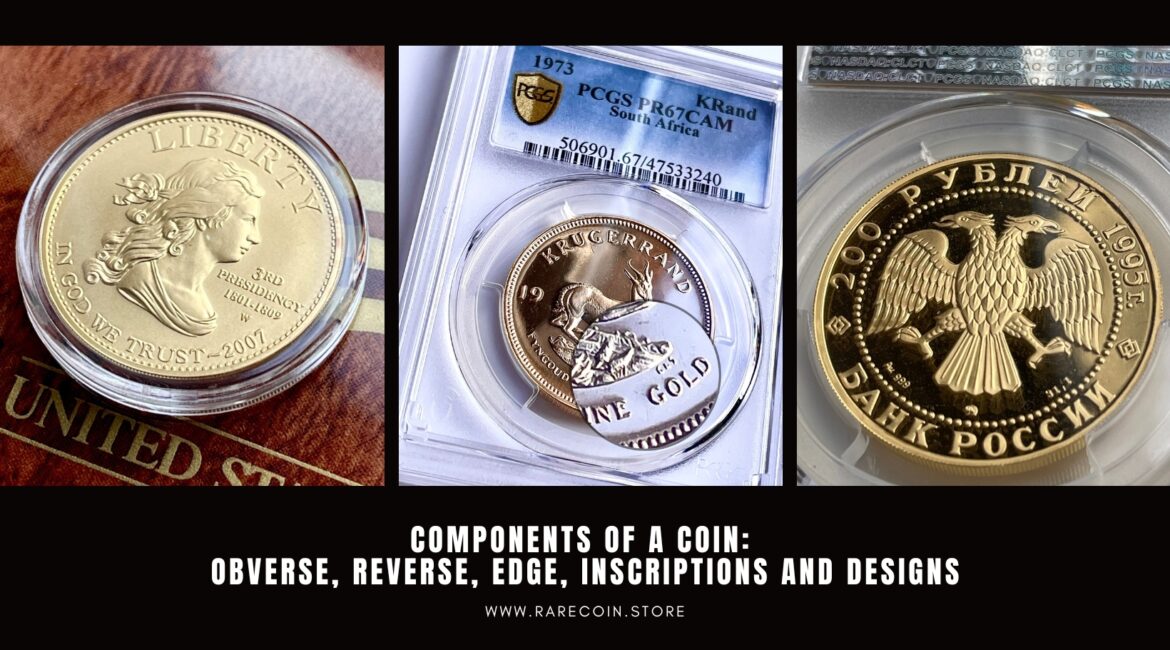How to read a coin – Components of a coin: obverse, reverse, edge, inscriptions and designs
This article is devoted to concepts that should be familiar to anyone interested in coins. In the following, we will explain the basic rules for distinguishing the obverse from the reverse of a coin, and examine important elements of the coin legend.
Gold coins are like open books that can be read. A detailed look at each coin can fascinate and inspire for hours. Let’s start by clearing up the confusion:
Where is the obverse and where is the reverse?
Yes, for numismatists this is often obvious. However, for those who don’t deal with money and coins, this can be confusing. The distinction between the obverse and reverse of a coin from an exotic country may not be easy at first glance, as there are no clear guidelines for this distinction. However, in the absence of a reliable catalog, you can be guided by the features of the front panel.
On the obverse, also known as obverse, the denomination, the year of issue, the denomination of the precious metal, the degree of alloy, the weight of the pure precious metal and the mint mark are indicated. This allows you to always see whether, for example, Russian coins were minted in the MMD (Moscow Mint) or SPMD (Saint Petersburg Mint). All drawings and inscriptions on the front side are applied in relief.
The reverse, also known as the lapel, depicts images of buildings, animals, monuments, names of designers, and other motifs.
Example: Krugerrand – 1973 – 1oz Proof Gold – PCGS PR67 Cameo: Designer: (bottom right) CLS (Coert Laurens Steynberg, sculptor, 1905-1982)
The portrait of a ruler or monarch is almost always on the obverse. For the United States of America, the symbolic motif is Lady Liberty, the personification of freedom in female form. In modern US coins, the artistic image is often replaced by the word “Liberty”. Today, the image of the Statue of Liberty is embossed on gilded brass dollars.
In summary: Normally, the obverse presents the portrait of the President of the Republic, the national coat of arms or the name of the country, as well as the place where the coin was minted. However, there are occasional exceptions to these conventions, which means that there may be coins that do not meet the definitions mentioned.
The edge is the side surface of the coin that protrudes beyond the relief image on both sides
The edge of the coin is extremely important for numismatists. Originally, coins had no edge. But in turbulent times, the weight of the precious metal had to be protected from manipulation by sawing off or biting off. For this reason, a mechanism was developed to emboss the pattern on the blank.
The legend is the textual part of the coin design
The legend not only displays the text on the front or back, but can also be present on the coin field. Circular legends are a circular or arched inscription on the edge of the coin. The legend can also be integrated into a drawing. Coin catalogs try to represent the legend as completely as possible. It contains not only letters and numbers, but also symbols representing the emblem of the issuing bank, the mint and the person in charge.
The total weight refers to the total weight in grams
The grading (slabbing) of coins
Grading (slabbing) of coins is a service for evaluating the authenticity and degree of preservation of coins. In this case, the specimen examined is enclosed in a transparent plastic container, together with a certificate containing information on the country of issue, denomination, date of issue and degree of conservation. You may also be interested in: Grading a coin: NGC and PCGS
Relief of a coin
The structures, elevations and other design elements on the surface of a coin determine its relief. Of course, when minting in the mint, all products must be absolutely identical. Nevertheless, occasionally coins of the same face value may have minor features in relief that are barely noticeable at first glance. This may be due to technical irregularities, violations of manufacturing processes or human influence. Regardless of the cause, whether it is a manufacturing defect or any other reason, the design of the relief affects the value of the coin, especially the inscriptions engraved on it. Especially for collectors and numismatists, mints sometimes publish editions that have a clearer and mirror-like polished relief. Such coins bear the special name “Proof”. They retain their original appearance longer and have significant value.
The field of the coin
Despite the relief, which does not fill the entire surface of the obverse and reverse of the coin, a section of the obverse and reverse remains smooth and is surrounded by protruding relief structures. This area is called the coin field. In some metal money variants, such as Canadian dollars, this part is polished during production and brought to a shiny mirror state.
Just like other aspects of the coin, the condition of the coin flat, its integrity and any damage (scratches, abrasions) is of considerable importance for numismatists and collectors!
Two main types of conservation levels:
Firstly, the technical production methods of coins such as “proof” or “uncirculated”. These production methods are objective and easily recognizable.
Secondly, the actual state of preservation of a coin, which by its nature can vary greatly and therefore requires a more precise classification and description than just specifying the original production method.
A proof coin is a process in which the surface has a clean mirror field and a matte relief image, as well as inscriptions. As a rule, such pieces are made for collectors.
Collector coins are coins with a small mintage and high artistic quality, which are mainly minted from precious metal. They are intended for sale to collectors, which is why the face value indicated on them has nothing to do with the actual price. An increasing number of people are increasingly interested in coin collecting, that is, numismatics, as this process is extremely captivating and exciting. In addition, the value of a rare coin increases in proportion to its minting and distribution.
Why is it beneficial to understand the language of coins?
Quite simply – this knowledge greatly facilitates the identification of a coin, as well as the assessment of its value. Get in touch with us if you have any questions about one or more coins. We are at your disposal.
Discover the new additions to our gold coin collection in the current range!
-
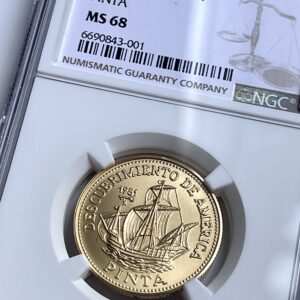
Cuba – 1981 – 100 Pesos – Pinta – NGC MS68
1.400,00 €plus shippingDelivery Time: approx. 2-3 days (excluding Saturdays, Sundays and public holidays) -
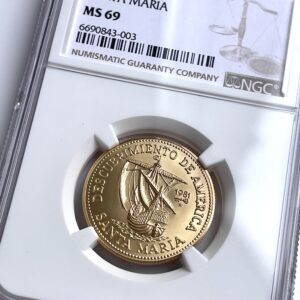
Cuba – 1981 – 100 Pesos – Santa Maria – NGC MS69
1.400,00 €plus shippingDelivery Time: approx. 2-3 days (excluding Saturdays, Sundays and public holidays) -
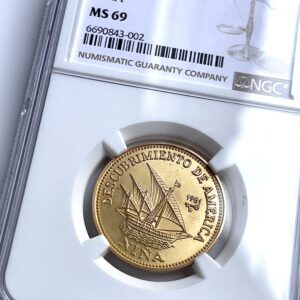
Cuba – 1981 – 100 Pesos – Nina – NGC MS69
1.400,00 €plus shippingDelivery Time: approx. 2-3 days (excluding Saturdays, Sundays and public holidays) -
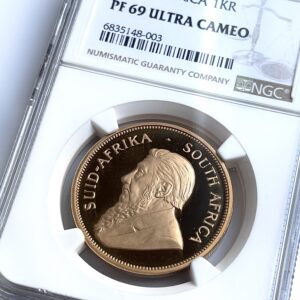
Krugerrand – 1993 – 1 oz Proof Gold Coin – NGC PF69 Ultra Cameo
3.300,00 €plus shippingDelivery Time: approx. 2-3 days (excluding Saturdays, Sundays and public holidays) -
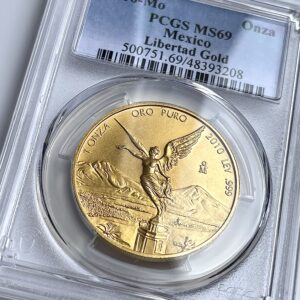
Mexico – 2010 – Libertad – Gold coin 1 oz – PCGS MS69
3.150,00 €plus shippingDelivery Time: approx. 2-3 days (excluding Saturdays, Sundays and public holidays) -
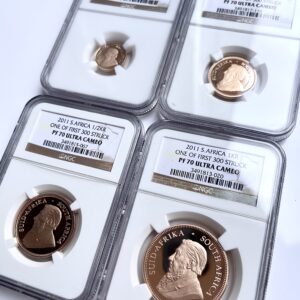
Krugerrand – 2011 – Set – One of First 300 – 4 Gold Coins Proof – NGC PF70 UCAM
5.500,00 €plus shippingDelivery Time: approx. 2-3 days (excluding Saturdays, Sundays and public holidays) -
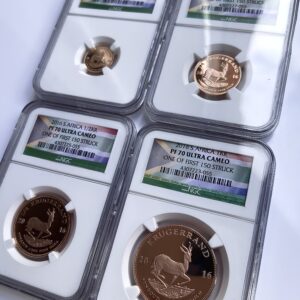
Krugerrand – 2016 – Set – One of First 150 – 4 Gold Coins Proof – NGC PF70 UCAM
5.500,00 €plus shippingDelivery Time: approx. 2-3 days (excluding Saturdays, Sundays and public holidays) -
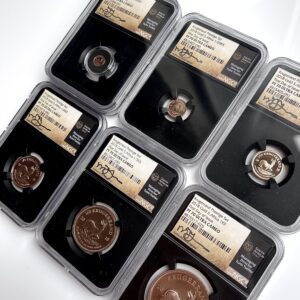
Krugerrand – 2018 – Set – First Day of Issue – 6 Gold Coins Proof – NGC PF70 UCAM
5.750,00 €plus shippingDelivery Time: approx. 2-3 days (excluding Saturdays, Sundays and public holidays) -
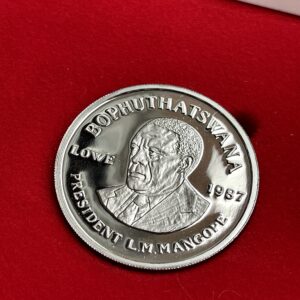
Bophuthatswana – 1987 – 10 years of independence – platinum – 1oz – with original case and certificate
2.195,00 €plus shippingDelivery Time: approx. 2-3 days (excluding Saturdays, Sundays and public holidays) -
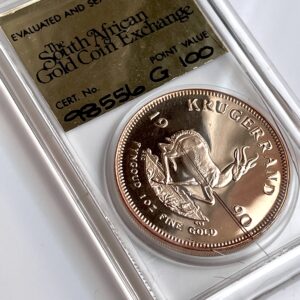
South Africa – Krugerrand – GRC – 1990 – SAGCE PoV 100 – 1oz Proof Gold
3.250,00 €plus shippingDelivery Time: approx. 2-3 days (excluding Saturdays, Sundays and public holidays)

